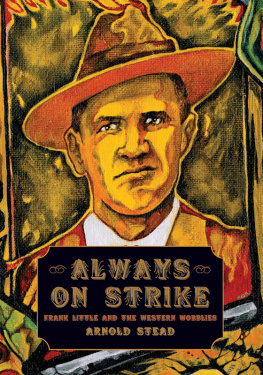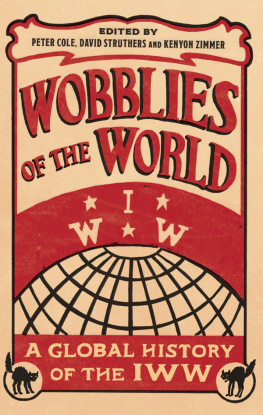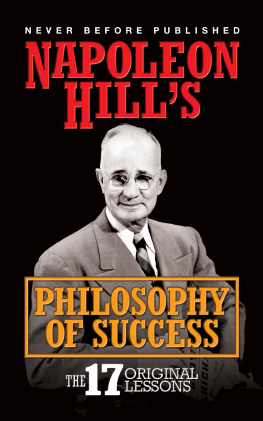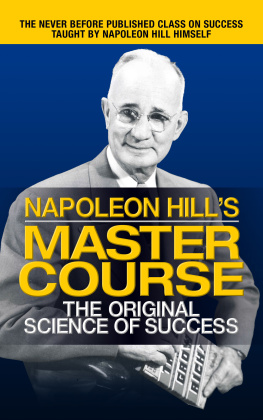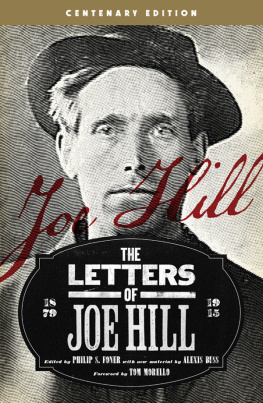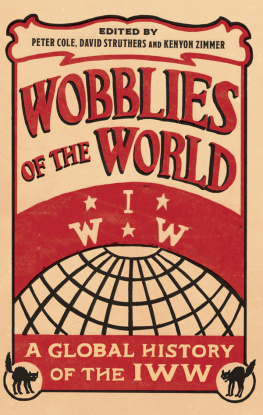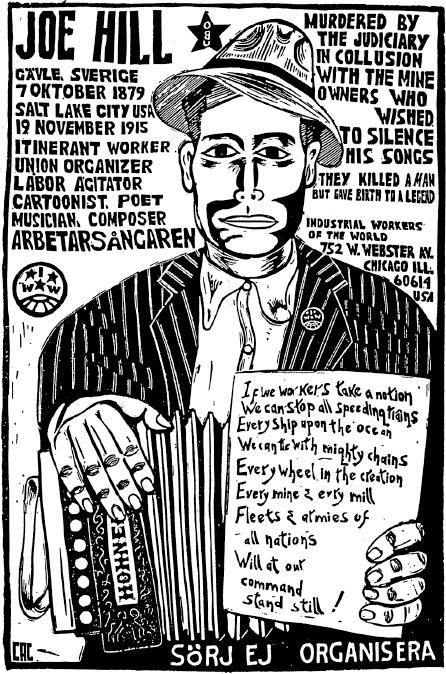
Carlos Cortez: Joe Hill poster (linocut, 1973)
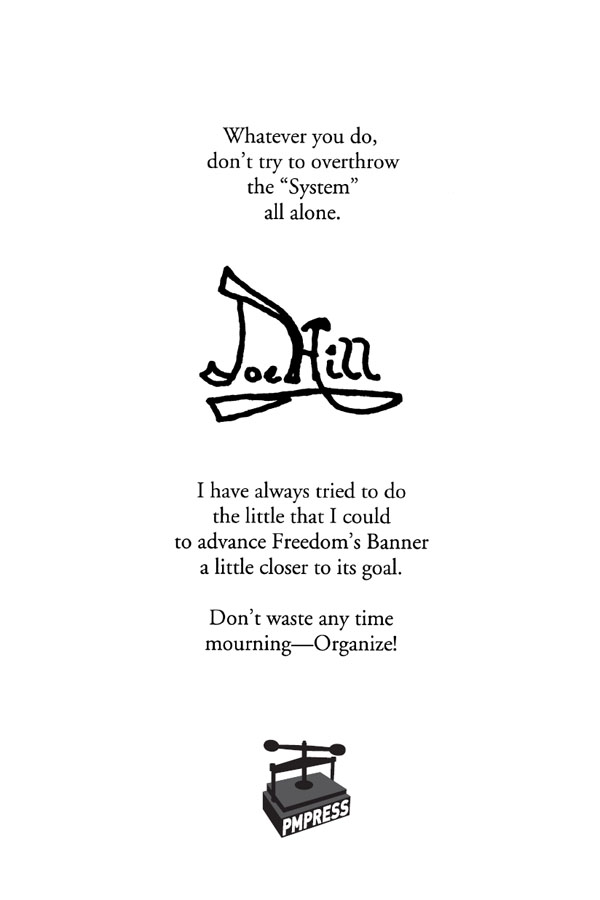
Joe Hill: The IWW & the Making of a Revolutionary Workingclass Counterculture, Second Edition Franklin Rosemont
PM Press 2015
All rights reserved. No part of this book may be transmitted by any means without permission in writing from the publisher
Introduction David Roediger 2015
| PM Press | C.H. Kerr Company |
| PO Box 23912 | 1726 Jarvis Avenue |
| Oakland, CA 94623 | Chicago, IL 60626 |
| www.pmpress.org | www.charleshkerr.com |
Cover design by Josh MacPhee
ISBN: 978-1-62963-119-6 Library of Congress Control Number: 2015930903
This edition first published in Canada in 2015 by Between the Lines
401 Richmond Street West, Studio 277, Toronto, Ontario, M5V 3A8, Canada
1-800-718-7201
www.btlbooks.com
All rights reserved. No part of this publication may be photocopied, reproduced, stored in a retrieval system, or transmitted in any form or by any means, electronic, mechanical, recording, or otherwise, without the written permission of the publisher or (for photocopying in Canada only) Access Copyright www.accesscopyright.ca.
Every reasonable effort has been made to identify copyright holders. Between the Lines would be pleased to have any errors or omissions brought to its attention.
Library and Archives Canada Cataloguing in Publication
Rosemont, Franklin, author
Joe Hill : the IWW & the making of a revolutionary working class counterculture / Franklin Rosemont.
Co-published by: PM Press.
Reprint. Originally published: Chicago, Il. : C.H. Kerr Pub., 2003, c2002.
Includes bibliographical references and index.
Issued in print and electronic formats.
ISBN 978-1-77113-233-6 (paperback).--ISBN 978-1-77113-234-3 (epub).ISBN 978-1-77113-235-0 (pdf)
1. Hill, Joe, 1879-1915. 2. Industrial Workers of the World--History. 3. Working class--United States--History. 4. Labor movement--United States--History. I. Title.
| HD8073.H55R68 2015 | 331.8860973 | C2015-903801-4 |
| C2015-903802-2 |
| ISBN 978-1-77113-233-6 | Between the Lines paperback |
| ISBN 978-1-77113-234-3 | Between the Lines epub |
| ISBN 978-1-77113-235-0 | Between the Lines pdf |
10 9 8 7 6 5 4 3 2 1
Printed in the USA by the Employee Owners of Thomson-Shore in Dexter, Michigan.
www.thomsonshore.com
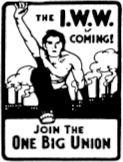
To
ARCHIE GREEN,
the Shakespeare & Hegel of laborlore,
and to the memory of
Joe Hills friends:
WILLIAM CHANCE,
ALEXANDER MACKAY,
LOUIS MOREAU,
& SAM MURRAY,
Wobblies true-blue.
Human emancipation
remains the only cause
worth serving.
Andr Breton
All for One & One for All!
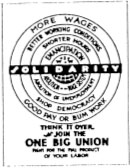
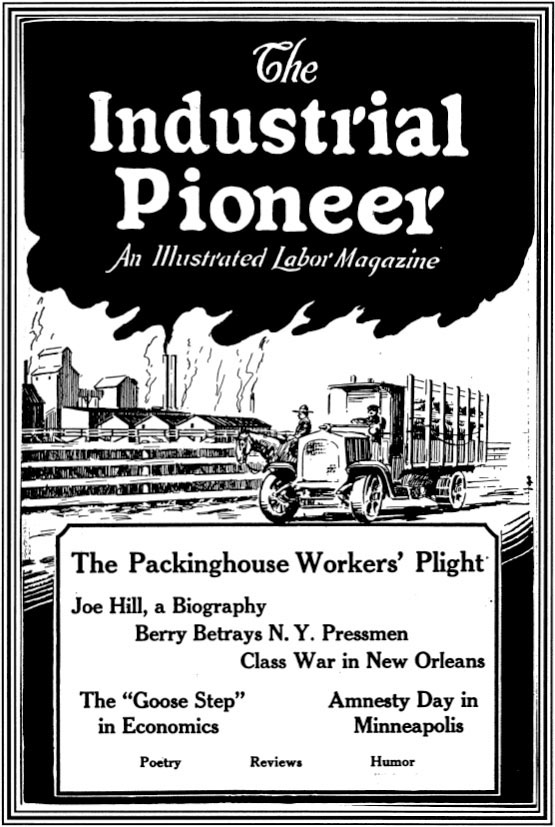
The first biography of Joe Hill, by Ralph Chaplin, appeared in this 1923 IWW magazine
TABLE OF CONTENTS
JOE HILLS ARTWORK
(in order of appearance in this book)
1 (). Cover of IWW Songs (Los Angeles edition, 1912), probably designed and lettered by Joe Hill, who edited the volume.
2 (). How the Memory Doth Linger (sketch of Sam Murray) (1915).
3 (). Cover design, sheet music for A Trip to Honolulu (1915).
4 (). Cataract. Oil painting (pre-1902).
5 (). Ive Got a Mission to Fill (self-portrait). Hand-drawn postcard (29 April 1911).
6 (). As It Was, As It Is. One Big Union Monthly (November 1919).
7 (). Class War News: IWW Submarines Are Annoying the Enemy Everywhere. Industrial Solidarity (24 October 1914).
8 (). Oh you Hoboing. Hand-drawn postcard (2 September 1911).
9 (). Mr and Mrs Highbrow. One Big Union Monthly (November 1919).
10 (). Constitutional Guarantee. Industrial Worker (24 April 1913).
11 (). Doings of Vran Kalle. Hand-drawn postcard (24 January 1911).
12 (). AerogramHelp! Help! Weve Hit Something! Cartoon for IWW Songs (Los Angeles edition, 1912).
13 (). Cover art, sheet music for The Rebel Girl (1915).
14 (). Cover art, sheet music for Workers of the World, Awaken! (1915).
15 (). Merry Xmas and Then Some. Hand-drawn and colored postcard (18 December 1911).
A NOTE ON THE NOTES
Rather than clutter an already ample volume with another hundred-plus pages of notes, I have used throughout a variant method of citation. Basic referencesciting author, year of publication, and page numbersare included in the text itself, often but not always in brackets. Further details (e.g., title and publisher) can be found in the Bibliography in the back of the book. Thus the bracketed notation [Adamic 1932, 247-249] refers the reader to the exact page of a book or article by Adamic published in 1932. In many cases author, title, year of publication are all supplied in the actual text, and only the page numbers are in brackets; for example: In the modern labor movement, as Pat Read noted in the July 1937 One Big Union Monthly, the IWW alone has made a systematic attempt to popularize the songs of the struggle [21].
Two exceptions should be noted. It seemed confusing, when quoting Joe Hills own letters, to cite Foner, editor of a volume of these letters; I have therefore simply cited the source as Letters, followed by page numbers. Similarly, the volume of printed proceedings of the IWWs Founding Convention, which has neither author nor editor, is cited as Proceedings 1905, followed by page numbers.
In quoting letters or interviews, names of the writer and addressee, or interviewer and interviewee, as well as the date (when known) are provided in the text; a corresponding sub-section of the Bibliography notes the libraries or private collections in which these letters and interviews are housed. The few actual endnotesat the end of chaptersare mostly elaborations of points made in the text.
Introduction to the 2015 Edition
F or me, the three greatest works in working class history to appear since E.P. Thompsons The Making of the English Working Class are Walter Rodneys The History of the Guyanese Working People, Peter Linebaugh and Marcus Redikers The Many-Headed Hydra, and Franklin Rosemonts Joe Hill. They share a sense of their own creation that makes it clear that each is a collective work, drawing on the energies and expertise of other scholars and the breakthroughs generated by social movements. As Rodney wrote in the preface to another of his classic works, How Europe Underdeveloped Africa, I will not add that all mistakes and shortcomings are entirely my responsibility. That is sheer bourgeois subjectivism. Responsibility in matters of these sorts is always collective, especially with regard to the remedying of shortcomings. Or as Franklin put it in closing this book, A couple hundred people, in many and varied ways, kept offering good ideas and information, and helped me to write [
Next page


